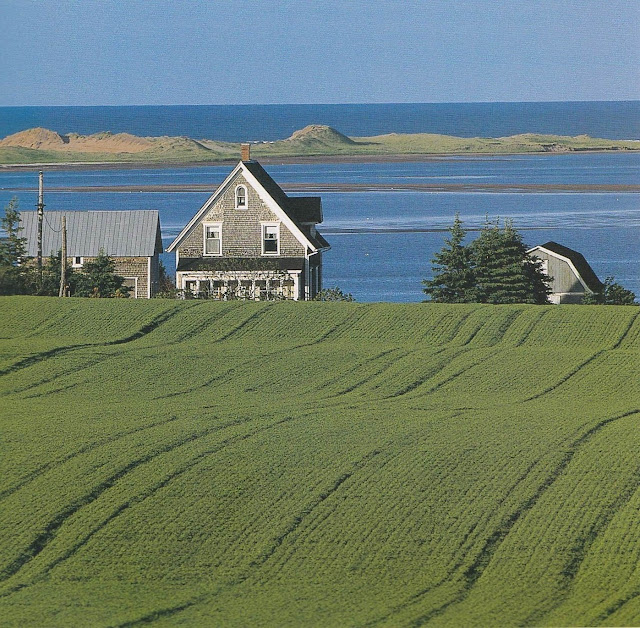by Adjutor Rivard
Canadian Stories in Verse and Prose, 1932
We children were afraid of it and never ventured near. And yet the garden gate was open – lying on the ground, indeed, with broken hinges; and no one was there to say you nay. On the way back from school or church – we were preparing then for our first communion – it would have been pleasant enough to stop half way and rest awhile on the low steps of the deserted house; the more so as plums, cherries, apples and gooseberries ripened in the orchard close by, and self-sown flowers, over-running the walks, fought with the rankly growing weeds for a share of sun and dew. It was free to anyone; yet we hastened along fearfully, without pausing.
The house was to us a sepulchre by the roadside. Planks roughly nailed across door and windows barred up the melancholy abode. Never a wisp of smoke curled from the stone chimney; never a ray of sunlight fell across the threshold; never a gleam shone through those blinded eyes. Sightless and deaf, the house seemed indifferent alike to the wide glory of the fields, to the swish and rustle of the wind over the meadows. Nothing stirred its chill insensibility; no human voice waked an echo within. Human? - but had not he night wind borne long-drawn mournful cries to many passerby from out the dead habitation?
One of us was tearing the boards from a window to look in, but none had the hardihood to venture. There might be something frightful beneath that roof, shadows would be stealing about behind those fastened windows. Were you eyes to fall on a room draped in black with a coffin and a corpse and candles burning!…In the evening we kept to the far side of the road and turned away our heads; afraid of what we might see.
If the house did not shelter the ghosts of our childish imagining, walls harboured sad memories, and departed days still were haunting the empty rooms.
Once the abandoned house was full of life and happiness, - happiness in the laughter of many children and the light-hearted mirth of grandparents; - life made beautiful by the toil that hallows every passing day and builds strong souls. For a century and more, sons succeeded father s in the possession of these sunny acres which never failed of nourishment for all. For a century and more, children were born, lived there lives and died in this same house, now forsaken; and of them every one as he made ready for his last journey sent a departing glance of farewell through this window across these same woods and fields.
But a day fell when the property descended to an heir in whom the ancient spirit dwelt not. This lover of indolent ways grudged the earth the travail of his hands and sweat of his face, and the earth denied him increase. Bread was lacking in the house. In his aliened heart he cursed the soil which yearned only to be fruitful and mourned the barrenness of its untilledfields. In a vision of easy-won affluence the faithless habitant took the resolve to desert his country. Selling beasts, furniture, all that pertained to his farm; barring the door and the windows of this home of his people as one nails up a coffin, he went his way.
And since the house the emigrant’s house has stood closed and empty, as though under a malediction; a place of terror for children, of melancholy to their neighbors, and open wound in the parish.
Have those who so depart full consciousness that in doing it they meanly quit the post of honour, are recreant to high duty? Do they lightly imagine that they are leaving behind only four walls and a roof? In truth they had abandoned and forswear is no less than their native land! For one, the mountains, for another, the plain. But whether on hillside or in hollow, here lies the parish in which their ancestor’s quiet lives slipped by, the church where they bent the knee, the earth that guards their bones; the farm which throve by dint of their harsh incessant toil; the precious store of household tradition, the wholesome fireside ways; worship of the past and reverence for its memories; nay, it may be, the very speech of their fathers and the faith itself that sustained them. This, all rich inheritance do they toss away; and their own country thrown with careless hand into the barter!
And yet I beseech thee, O Mother Earth, set not they curse upon those who have gone, for all are not so thankless. If some have denied and forgotten thee in the smoke and din of cities, know that hard fate alone has driven many forth, and that in remoteness they keep faith with thee, dream of thee still, love thee before the land of their sojourning. O Mother Earth, be mindful of them under whatsoever skies they larbour, for they are yet thy children. They keep alive their country’s soul in strange lands, and practice the lessons thou has taught them in youth.
Await them hopefully, kind Mother. Tender and merciful, give them welcome on the day when exile passes their enduring and fate permits them to return. Border the way with brightest flowers, shed abroad a warmer light, deck thyself in freshest loveliest green to greet their homecoming. Yield thy broad bosom to the plough-shares of thy returning sons, O fruitful Mother; take to they furrows the seed flung by their scarred hands; joyously send up the tall heavy-headed wheat; let the grass spring lush in the meadows and the woods be filled with pleasant sounds; waft through all the opened windows of the re-awakened house the fragrant breath of new-mown
hay!-------------------------------------------------------------------------------
Above Photo: House in Monticello, Prince Edward Island




.jpg)







.jpg)

.jpg)
.jpg)




























.jpg)